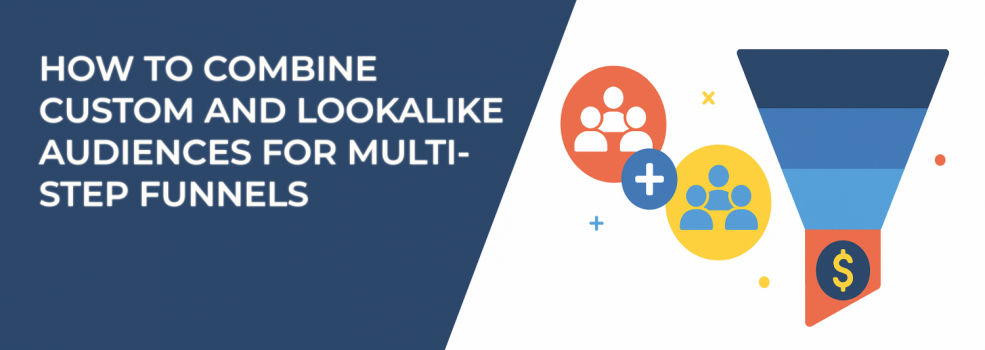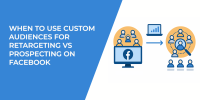Running a Facebook ad funnel without the right audience strategy? You’re likely wasting budget.
Custom and lookalike audiences each serve a different purpose — but most advertisers don’t combine them well. The result? Funnels that stall, scale poorly, or convert inconsistently.
In this guide, you’ll learn how to use both audience types together across every stage of the funnel, so you reach the right people, at the right time, with the right message.
Why You Can’t Use the Same Audience for Every Funnel Stage
Think about your customer’s journey. It’s not linear, and it’s not one-size-fits-all. So why would your audience strategy be?
Each funnel stage — awareness, consideration, and conversion — attracts people with different behaviors, intentions, and readiness. Using the same audience type across all stages leads to poor targeting, mismatched messaging, and wasted budget.
To fix that, you need a clear role for each audience type:
- Lookalike audiences help you scale intelligently by finding cold prospects who behave like your best customers.
- Custom audiences help you retarget warm leads and re-engage users who already know you.
Used correctly, these two audience types create a seamless path from scroll to sale.
If you're not confident about the fundamentals of targeting, this Facebook Ad Targeting 101 guide breaks down how to reach the right audience from the very start.
Top of Funnel: Use Lookalike Audiences to Scale Smart
When you’re trying to reach people who’ve never interacted with your brand, lookalike audiences are one of the most effective tools in Meta’s arsenal. But their success depends heavily on the quality of the source data you give them.
Here are the best types of seed audiences to use when creating lookalike audiences for the top of the funnel:
-
High-value customers — those with the largest order sizes, highest retention, or most referrals.
-
Recent purchasers — especially buyers within the last 30 days, since their behavior is fresh.
-
Video viewers (75% or more) — people who watched most of your content and showed interest.
-
Engaged social media users — those who commented, liked, saved, or shared your content.
These seed audiences allow Facebook’s algorithm to find similar users who are more likely to show interest and engage. You're not just casting a wide net — you’re casting a smart one.
To make the most of these audiences, apply the following tactics:
-
Use 1%–2% lookalike ranges for better precision, especially if your budget is limited.
-
Create multiple lookalike audiences from different seed sources and test them against each other.
-
Always exclude current customers, website visitors, and email subscribers to ensure you’re truly reaching new users.
Once you’ve set this up, your TOFU campaigns will focus on discovery — reaching relevant cold audiences without overlap or redundancy.
Middle of Funnel: Retarget with Precision Using Custom Audiences
As users interact with your brand — click through ads, visit your landing pages, watch videos — they move from cold to warm. Now, it’s time to nurture them.
Custom audiences are ideal at the middle of the funnel (MOFU) because they allow you to retarget based on specific actions. You can now deliver more personalized messages that educate, build trust, and address objections.
Here are the most effective custom audiences to use in your middle-of-funnel campaigns:
-
Website visitors (past 14–30 days) — especially those who visited multiple pages or stayed longer.
-
Lead form starters or partial submissions — people who began a form but didn’t complete it.
-
Video viewers (50%–75%) — users who’ve shown meaningful interest.
-
Email subscribers — particularly those who opened multiple emails or clicked links without converting.
These audiences are warm — not yet ready to buy, but curious. Use this stage to build your case.
Your creative at this stage should feel informative and supportive. Here are a few directions to try:
-
Share customer testimonials, reviews, or success stories to build credibility.
-
Run ads that answer common objections or highlight specific features.
-
Offer free resources or lead magnets, such as guides, checklists, or webinar invites.
-
Introduce retargeting journeys with storytelling ads to deepen connection.
Always remember to exclude users who already converted (made a purchase, booked a call, etc.). Keeping your audiences clean ensures you’re not wasting ad spend or showing redundant ads to customers.
If you're building custom audiences for the first time or want to refine them, this complete guide to Facebook Custom Audiences walks you through what works and why.
Bottom of Funnel: Combine High-Intent Custom Audiences with Narrow Lookalikes
At the bottom of the funnel (BOFU), your audience is highly aware. They’ve already shown strong buying signals — now they need a final nudge.
This is where custom audiences shine again, but you can also add narrow lookalikes to scale up conversions without losing precision. Start with data-rich audiences, then build lookalikes that mirror high-intent actions.
The best-performing custom audiences for bottom-of-funnel targeting include:
-
Cart abandoners (last 7–14 days) — people who added to cart but didn’t buy.
-
Pricing or checkout page visitors — especially those who visited multiple times.
-
Lead form submitters — who haven’t yet converted or booked a call.
-
Product page viewers — users who repeatedly browsed specific offers.
Now, use these custom audiences to build 1%–2% lookalike audiences. This approach helps you find fresh users who resemble people already close to purchasing — often with lower competition and higher intent.
Pairing custom and lookalike audiences at this stage works well for:
-
Conversion-focused campaigns (purchases, bookings, demos).
-
Direct offers with urgency (limited-time discounts, last-call promos).
-
Dynamic product ads targeting cart abandoners or similar users.
Don’t forget to exclude recent purchasers, ideally in 7-, 14-, and 30-day windows, depending on your product lifecycle.
Still unsure when to use each audience type? This breakdown of custom vs lookalike audiences covers the pros and cons in real campaigns.
How to Avoid Overlapping Audiences Across Funnel Stages
Audience overlap is one of the most common — and expensive — mistakes advertisers make. If someone is in both your TOFU and BOFU ad sets, you’ll compete against yourself in Meta’s auction.
To avoid this, you need a clear system of exclusions and segmentation. Here’s how to stay in control:
Best practices to reduce audience overlap in Facebook funnel campaigns:
-
Exclude lower-funnel audiences from your top-of-funnel campaigns.
-
Set clear audience windows (e.g., website visitors in last 14 days for BOFU, 30 days for MOFU).
-
Break out campaigns by funnel stage, and assign audiences to match.
-
Regularly analyze delivery reports and audience breakdowns to spot inefficiencies.
This not only saves budget — it improves the experience for your audience, too. No one wants to see the same irrelevant ad in every stage of their journey.
Example Funnel Layout: Custom + Lookalike Audiences Working Together
Here’s what a clean, high-performing funnel could look like using both audience types:
Top of Funnel (Cold Users)
Introduce your brand and attract new users.
-
Lookalike 1%: High-value customers.
-
Lookalike 2%: Recent purchasers (last 30 days).
-
Exclude: All past website visitors, email subscribers, and leads.
Middle of Funnel (Warm Prospects)
Nurture, educate, and build trust.
-
Custom audience: Website visitors (last 30 days).
-
Custom audience: Engaged video viewers (50%+).
-
Custom audience: Facebook or Instagram engagers.
-
Exclude: Purchasers, booked calls, completed leads.
Bottom of Funnel (High-Intent Users)
Drive conversions with urgency and relevance.
-
Custom audience: Cart abandoners and checkout visitors.
-
Custom audience: Pricing page viewers (multiple visits).
-
Lookalike 1%: From cart abandoners.
-
Exclude: Purchasers in the last 7–30 days.
Final Thoughts
Facebook's algorithm is smarter than ever — but it still needs direction. By combining custom audiences for precision and lookalikes for scale, you feed Meta the signals it needs to serve better ads, to better people, at better times.
This method:
-
Aligns targeting with user intent at each stage.
-
Prevents wasted impressions and budget.
-
Boosts ROAS by optimizing message-to-market match.
-
Enhances user experience by moving users forward in the funnel — not looping them in circles.
When your audience structure mirrors your sales funnel, everything clicks. You stop blasting generic ads and start creating a smart, conversion-focused system.

